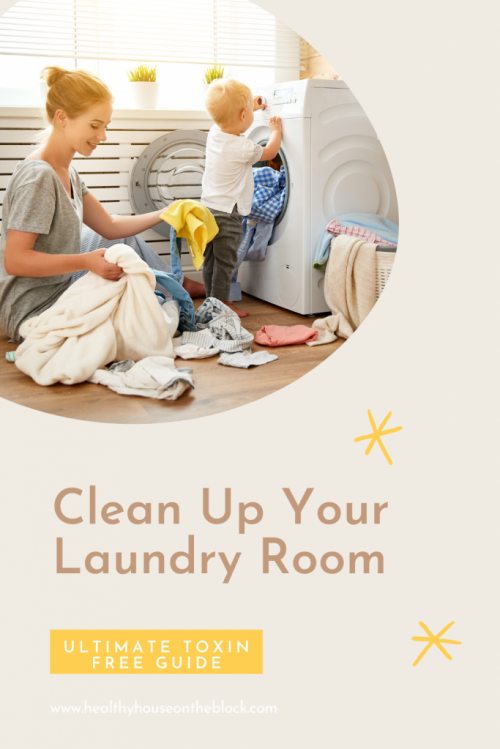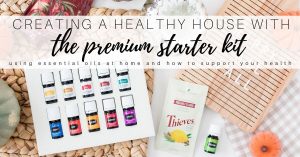
Families can create A LOT of laundry when you start to think about it. For me, laundry is a daily chore. Whether my six year old did a painting project at school or my nine year old “needs” to wear that pair of jeans for the third time this week. And don’t even get me started on the amount of laundry a tiny little 7 month old creates. And did I mention the work clothes, exercise clothes and every day outfits my husband and I wash? And that’s jus the clothes! There’s towels and sheets too. The piles are never-ending, which is just fine by me. Someday I’ll miss the tiny little clothes and if time keeps moving as fast as it is now, I’ll blink and my kids will be moving out and doing their own laundry (and hopefully the healthy way that I do; DIY fabric softener and all).
Whether you do laundry several times a day or you’re more of a once-a-week kind of family; it’s a space that can introduce A LOT of toxins into your home. The actual environment of the laundry room, laundry detergent and fabric softener (OH, and get ready for my DIY fabric softener tips coming later on) can all introduce chemicals and toxins to not only your clothing, but also your home’s indoor air.

The reason I like to really get a firm hold on laundry habits and laundry room health with my clients is because our clothing sits on our skin all day long. This means that any chemicals we’re using from detergents and softeners are ending up in embedded into our clothing.
Our skin absorbs anything that comes in contact with it, including residue from detergents and softeners that we use. And due to the long lengths of time that we’re exposing our skin to potential toxins in our laundry care products (we’re clothed close 98% of the day).
And as an advocate for clean and healthy spaces indoors, I think a lot times we miss the mark on the laundry room by just focusing on product swaps. There are some really simple and easy habits you can implement at home to clean up your laundry room space (yup! Beyond just an organic detergent or DIY fabric softener).
This post is going to help you create a healthy laundry room environment through healthy habits, preventative maintenance and reducing toxic products.
HEALTHY HABITS IN YOUR LAUNDRY ROOM
HUMIDITY: The simple chore of doing laundry, especially if you’re like me and seem to do a load every day, increases the humidity level in your laundry room by quite a bit. The heat and water from simply washing clothes evaporates into the air, causing the relative humidity in the room to rise. (If you need a refresh on the perfect humidity levels at home, head to this post)
The dryer will also increase the humidity in the room, as it pulls moisture out of the clothing and exhausts the air through the dryer vent outside.
And don’t think line-drying will reduce this problem. Line drying clothing is actually worse for the indoor humidity and will add more moisture to the air over time than drying the clothes in a dryer.
If you remember from previous posts, the more humid and warm an environment, the more toxins and VOCs off gas into the air. And the laundry room is prime real estate for humid and warm indoor air.
So how can you prevent adding moisture to the air in your laundry room or closet? You don’t have to dry your clothes outside and you don’t have to drastically change your habits. Nope. You can change just a few key things to make sure the humidity levels aren’t soaring inside.
- Use a window if you have one in your laundry area and crack it open while running the washer and dryer
- If your laundry area has a vented fan (similar to one found in a bathroom), run it while doing laundry and for about 20 minutes after finishing to eliminate as much moisture as possible
- Leave doors to the laundry room or closet open while doing laundry to allow moisture to escape the area
If you feel like the indoor air is super humid, you can also add a dehumidifier or fan to help move air around.
Remember that ideal humidity levels are around 35% – 45%. You can grab a simple hygrometer to measure the indoor air in your space to get an idea if it is on the high side.
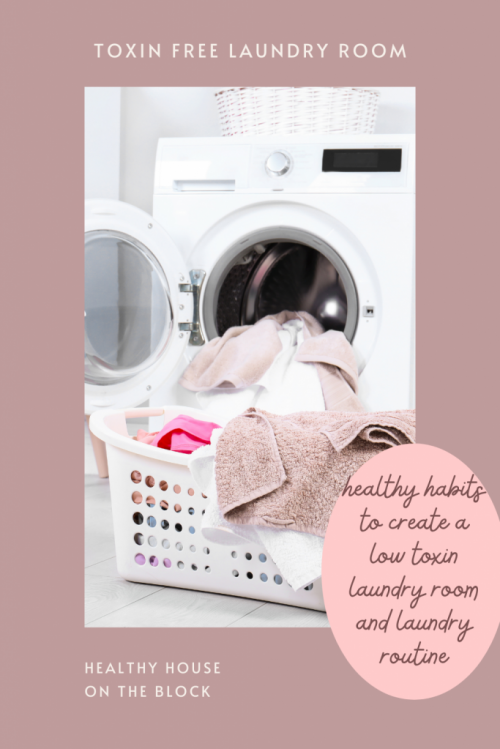
HEALTHY MAINTENANCE IN THE LAUNDRY ROOM: PREVENTING PROBLEMS
A laundry area can quickly become a nightmare when pipes leak or dryer vents are blocked. Taking extra precautions to make sure your laundry area is free from these issues will ensure catostrophe doesn’t strike and in turn add toxins to your space.
First, if your laundry room is above a finished space, you’ll want to make sure your washing machine has a disaster pan below it. Usually this is a basin that the washing machine sits in, however the basin also has a drain built in that allows any water leaking from the machine to be carried to a drain, rather than spilling out onto the floor and room below.
Second, check to make sure your washing machine has stainless steel braided supply hoses in the back. Older machines may have rubber hoses, which are more likely to leak and burst. Changing over to braided hoses will help prevent future leaks.
Next, check your dryer vent. You’ll want to check outside to make sure there is nothing blocking the vent. It’s a good idea to have the dryer vent cleaned every 1-2 years. You can do this yourself or hire a professional. Cleaning away extra lint is the key to keeping your home free of this fire risk.
Finally, check behind your dryer to make sure you don’t see an excess amount of lint. If you see a lot of lint in the area, it could mean that your dryer has become unattached from your dryer vent. This is another fire risk and should be dealt with right away.

HEALTHY PRUDUCTS (PLUS DIY FABRIC SOFTENER)

Laundry Detergents: Laundry detergents are made from more than just soap. Because we don’t scrub our laundry any more and we rely on a machine, bottles of laundry detergent contain surfactants, bleaching agents and preservatives.
A study done way back in 2008 by a University of Washington professor, reveals that there are hundreds of VOCs present in scented laundry products that end up in our air at home. These VOCs cause damage to the liver and kidneys as well as disrupt hormone production in healthy individuals.
Laundry detergents also often have elements of chlorine bleach in order “clean clothes”. We know that chlorine is harmful to the nervous system and irritates the airways.
And to cover up the smells of VOCs and bleach, laundry detergents also have added synthetic fragrances that are made up of chemicals harmful to our respiratory and nervous systems.
The synthetic fragrances that are added to laundry detergents is often times necessary in order cover up the unpleasant, chemical smell of the cleaner.
Below are my top picks for clean laundry detergents that you can use at home.
Fabric Softeners: Fabric softener was one of the first things I let go of when it came to cleaning up my cleaning products. I ditched the blue, smelly liquid and never looked back.
Fabric softeners contain a special group of toxins to help the fabric softener stick to your clothing fibers. This is what creates that soft feeling. For one, benzyl acetate is used but has been linked to pancreatic cancer.
Softeners also typically use ethanol and chloroform, which are both harmful to the nervous system. On top of these toxins, there’s also fragrance added as well as preservatives and colors that disrupt our body’s natural hormone production and have been linked to cancer.
There are just a few cleaner options on the market when it comes to fabric softeners, which I have listed below:
But, you can also take a stab at a DIY fabric softener option for your home, which is another great alternative to cutting out toxins in the laundry room:
- A simple solution of vinegar with a few drops of lavender essential oil in place of fabric softener is the simplest way to naturally soften clothing fibers.
- Try ¼ cup of ice cream or rock salt in the washing machine with your clothing to add an extra level of softness
- Try washing clothing in a cycle with just baking soda to remove any product build up from the fabrics and then wash with natural soap and softener to bring the fibers back to their natural form
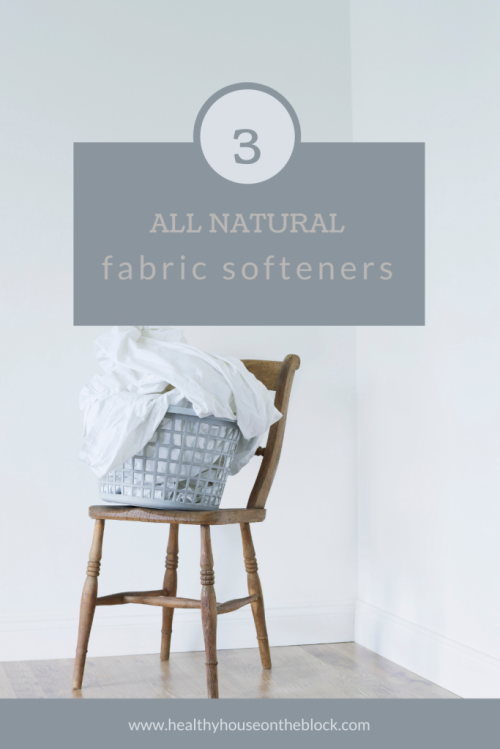
Dryer Sheets: Dryer sheets are another toxic product that I got rid of early on. Not only did I just not like finding them all over my house and stuck to the inside of my clothes, but they’re infused with many chemicals and unnatural scents. They often contain the same toxic chemicals as the fabric softener bottles.
Synthetic fragrance is a big toxin added to dryer sheets, which contains phthalates (damaging to reproductive health as well as disrupts natural hormone production).
The great news is you can completely replace dryer sheets with some all natural options:
- Use organic wool dryer balls (add a safety pin to get rid of static cling) with a few drops of your favorite organic essential oil.
- Soak cut up squares of old cotton t-shirts in a solution of vinegar and lavender essential oil and add them to the dryer with your damp clothes. Simply keep a jar of them on your dryer and refill them every few washes.
And if you just can’t ditch the dryer sheets, there are actually some healthier options out there that you can purchase:
Bleach: Nobody hates dingy, grey whites as much as I do. But bleach just isn’t an option in my house. The strong bleach odor should be a red flag to all of us — this product is made with harsh and unsafe chemicals. Bleach isn’t safe to be around kids, and to be quite honest, it’s not healthy for us either.
I don’t have bleach in my house and I don’t ever want to add it back in after finding out that the chlorine in bleach contributes to indoor VOC exposure. The use of bleach can contribute to poor indoor air quality and negatively affect the eyes, throat and lungs from the fumes.
To keep your whites white, use these safe and natural alternatives:
- Add baking soda, vinegar or hydrogen peroxide to your wash. Using about a ½ cup of any of these products is a great option to keep your whites bright.
- Soften your home’s water. You want to make sure your home doesn’t have overly hard water. Hard water will make any whites grey and kind of disgusting looking.
- Soak whites in a solution of hot water and washing soda (1/2 cup washing soda to 1 gallon of water). Soak as a prewash and simply launder as usual.
- Try out Mrs. Stewart’s Liquid Bluing — it’s great for keeping whites white (although not a stain remover)
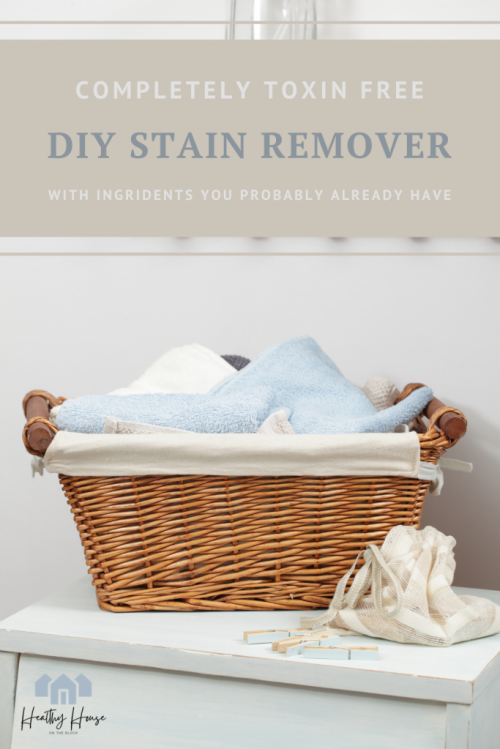
Stain Removers: Stain removers and myself have gotten pretty well acquainted over the past nine years of having kids. I’m still amazed at the stains that end up on clothes and usually there’s some creative story to go right along with it. But a lot of stain removers contain bleach compounds, fragrance additives and other surfactants and scrubbing agents that are harmful to our bodies.
I usually have a spray bottle mixed up of my own stain remover (1 part castile soap, 2 parts hydrogen peroxide and few drops of lemon essential oil). But you can also buy these premade low toxin stain removers in a pinch:
The laundry room is really a place where you can cut out a WHOLE lot of toxins. And in my opinion, it can be an easy place to swap out products. I know for me it took a little bit of time, but with some patience I ended up ditching all of the toxic products I had and switching over to some healthier options like my DIY fabric softener ideas and homemade stain remover. I’m so glad I did because it really gives me peace of mind knowing that my family isn’t negatively affected by what I’m choosing to do in the laundry.
